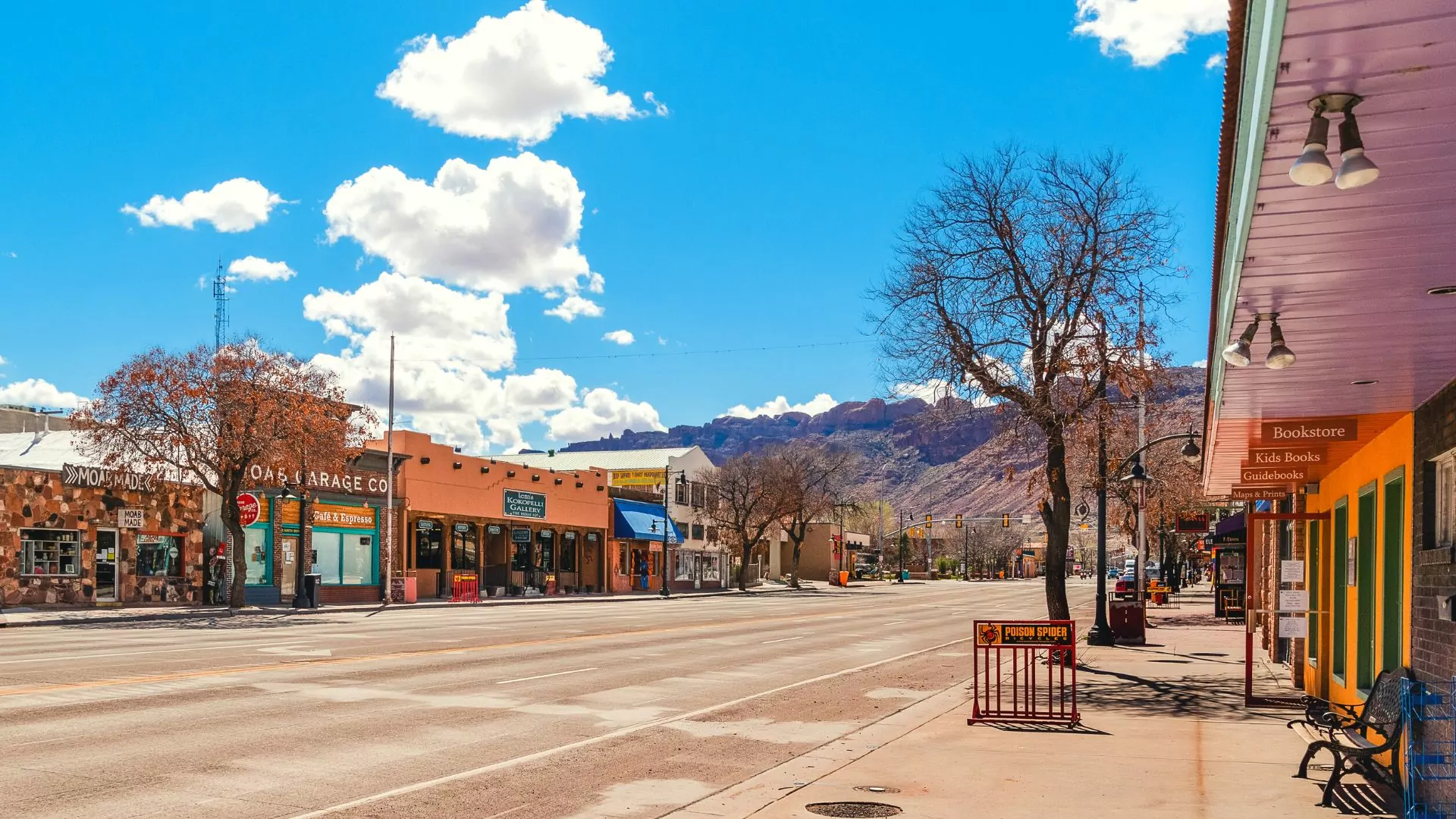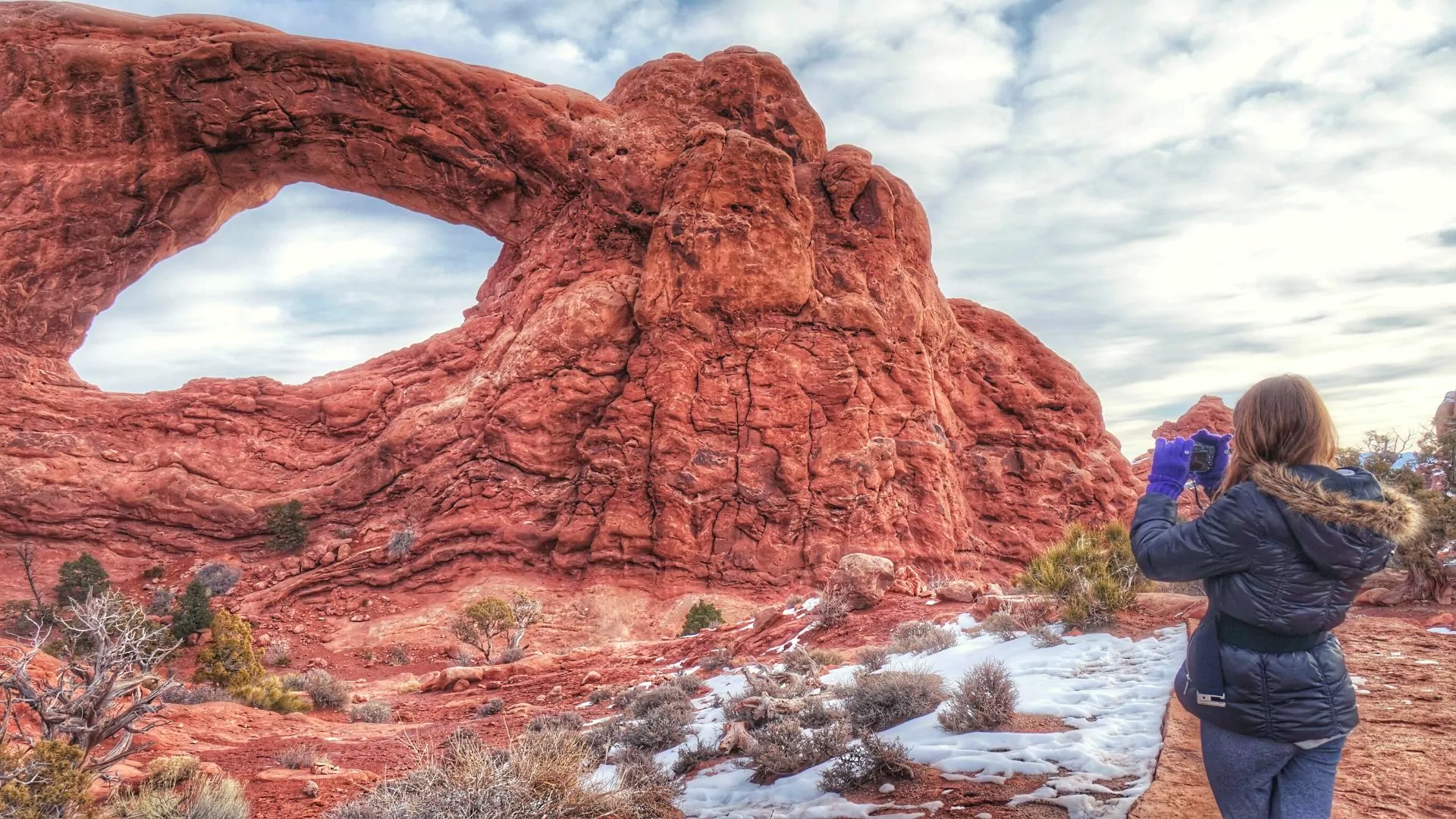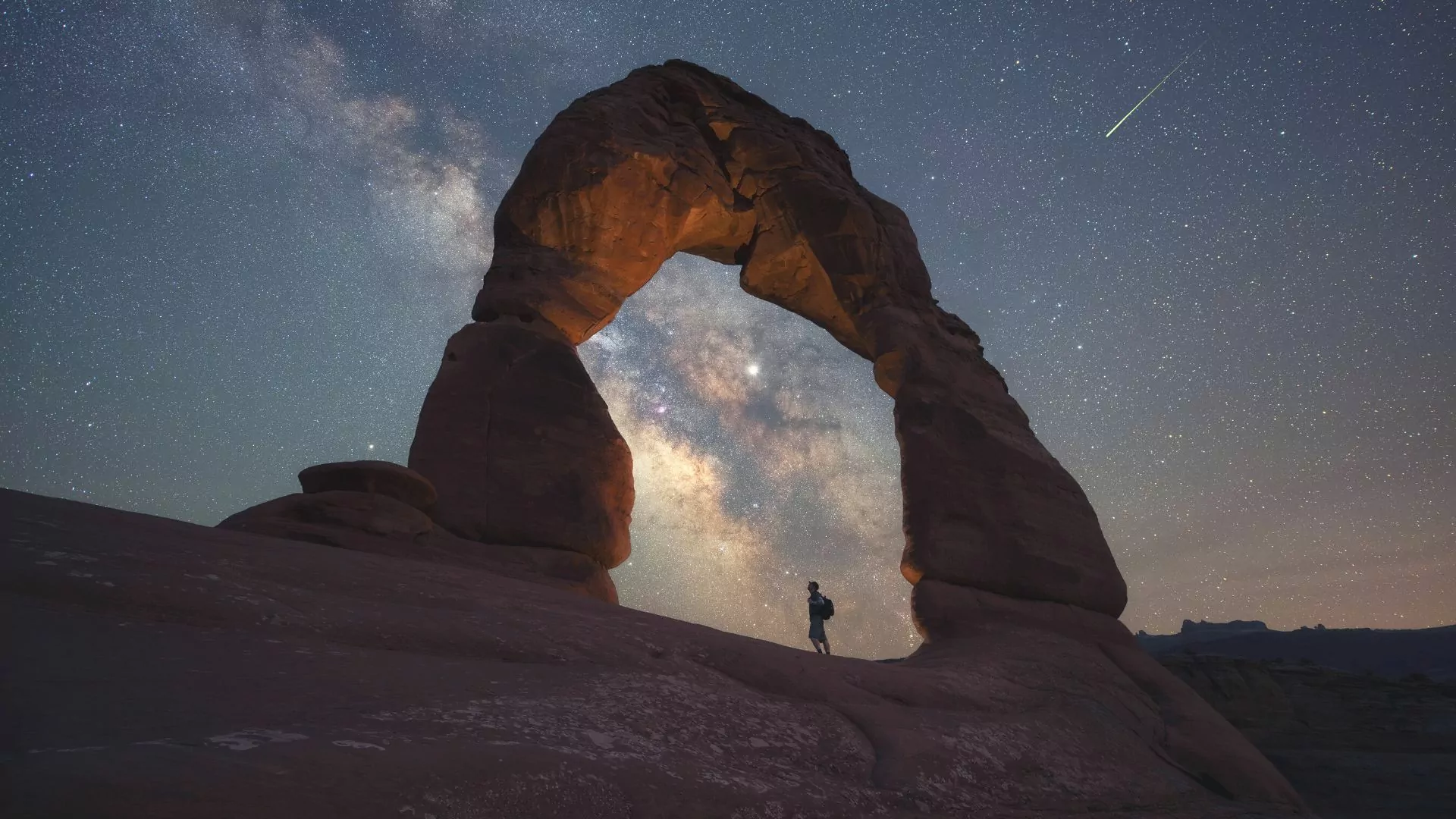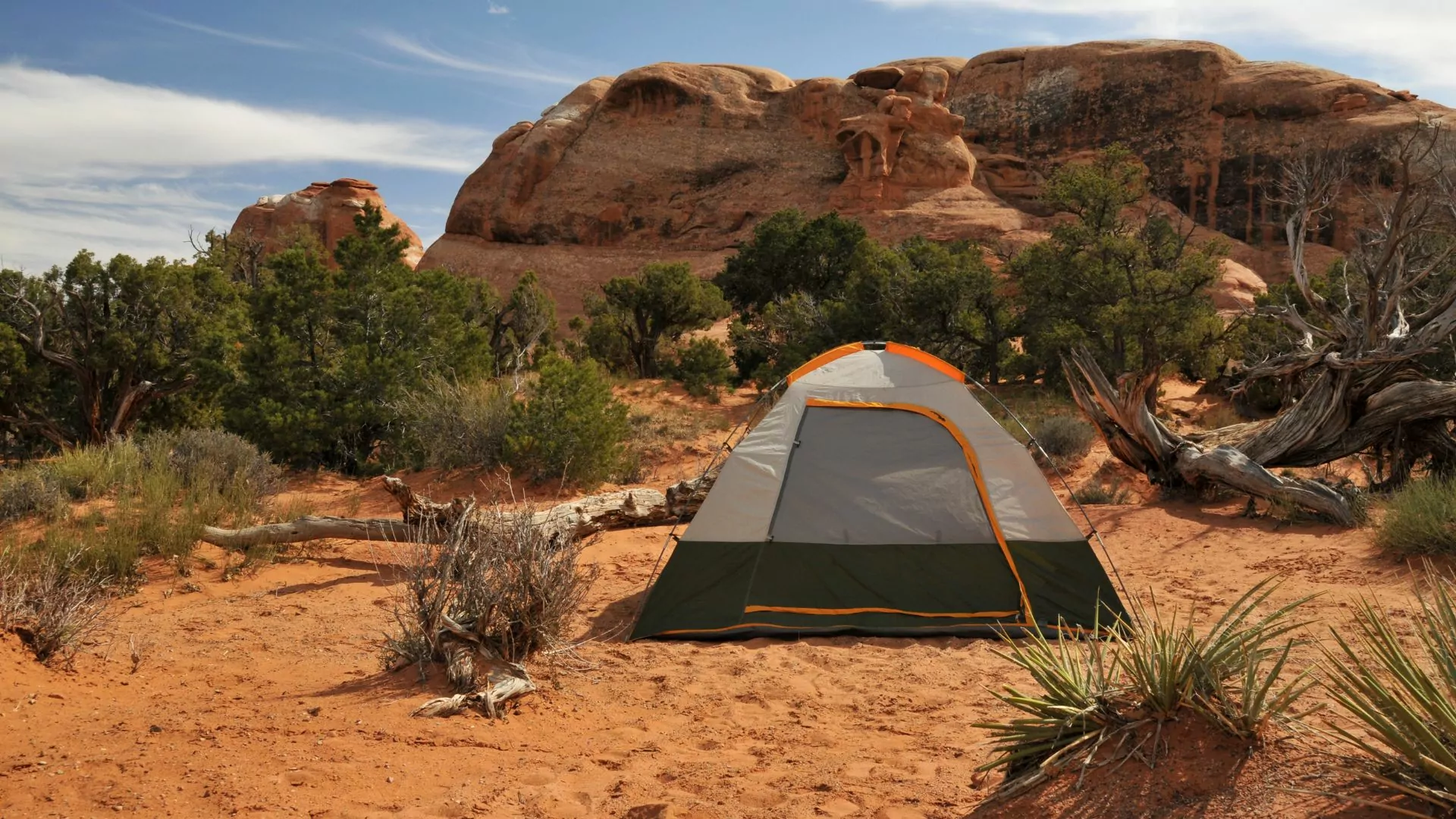The Ultimate Guide to Arches National Park
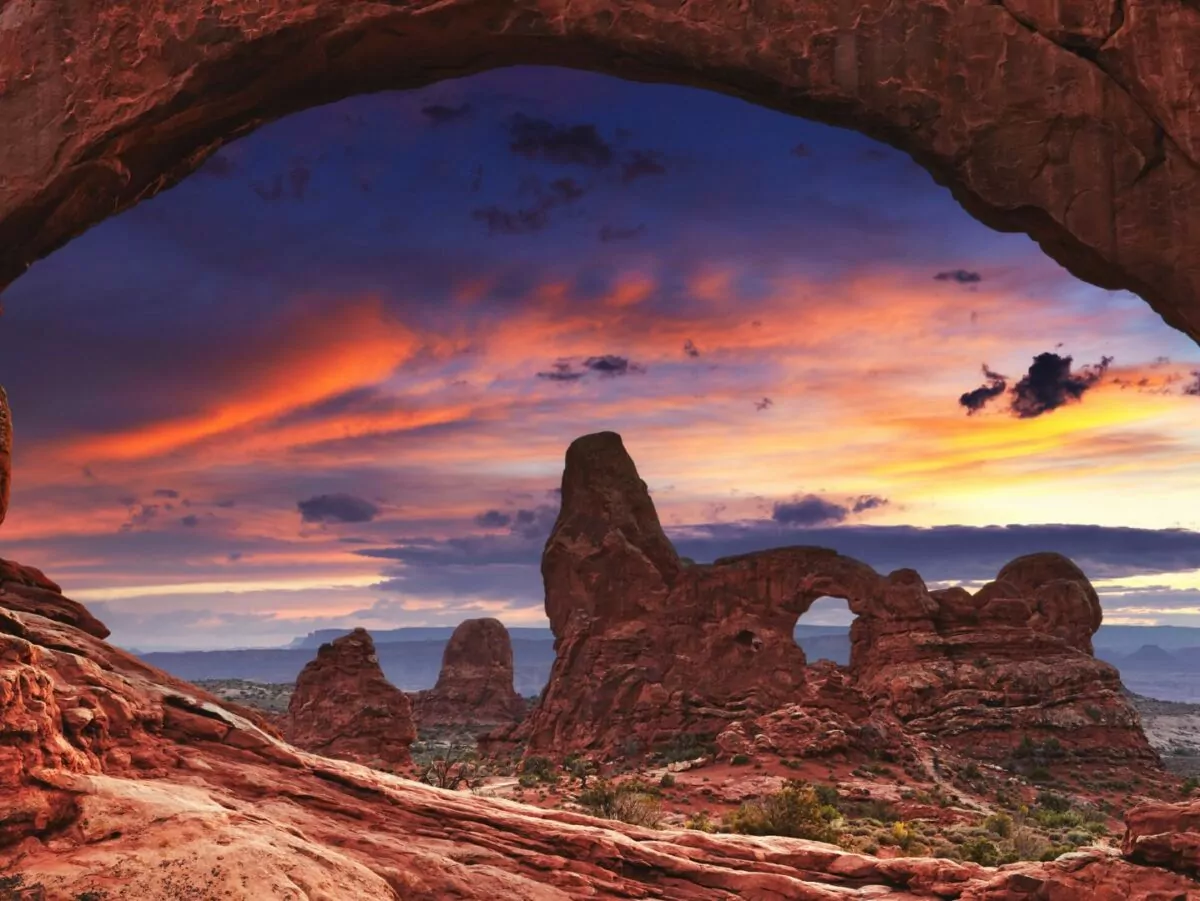
Nestled in the red-rock wonderland of Southeastern Utah, Arches National Park is a testament to the unrivalled beauty molded by the persistent forces of time and geology. Imagine being surrounded by towering sandstone fins and arches so large they appear otherworldly. As the sun gradually sets, the vast landscape transforms into a panorama of warm hues and dancing shadow, bathing the scenery with an exquisite glow. Arches National Park is renowned as a geological marvel, with its rock formations narrating the story of millions of years’ gradual weathering. Beyond these distinctive structures, the park has much to offer from rock climbing, to hiking, and sightseeing. Whether you’re a photographer, nature lover, or scenic picnicker, join us as we navigate the arches, canyons, and boundless beauty that make Arches National Park an unparalleled haven for outdoor enthusiasts.
History
The 119 square-mile parcel of land was initially designated as a National Monument by President Herbert Hoover in 1929, becoming a National Park in 1971. Prior to this transformation, the indigenous Fremont, Hopi, Navajo, Paiutes, and Utes were the original caretakers of the land. The park lies atop a salt bed that underwent extreme climate shifts millions of years ago, leading to flash floods and ocean waters compacting the rock, resulting in well-known arches and geological wonders like the Moab Fault. Arches has over 2,000 documented rock formations, including one so renowned it graces Utah’s license plate. With over 1.5 million annual visitors, explorers of this park are treated to endless towers, balanced rocks, massive stone bluffs, pinnacles, and petrified sand dunes.
Location
Located in Southeastern Utah, Arches National Park is 4 miles North (five minutes drive) of the acclaimed outdoor adventure city of Moab and 30 miles east (30 minutes) of Canyonlands National Park. Travelers can access the park via I-70, which traverses the central part of Utah, or choose from the Scenic Byway 128 (exit 204), or Highway 191 (exit 182) for a faster route to Moab. Others choose to fly into Grand Junction airport and make the 1-and-a-half-hour drive to Arches. Moab does have a small airport with limited service, but it is expensive and offers few connecting points.
Know Before You Go
Planning a trip to Arches requires flexibility, preparation and planning ahead. Here are some crucial considerations for travellers:
Big Crowds and Parking Issues
Arches’ busy season is from April to October. As temperatures soar up to 100 degrees during the summer, crowds peak. If you intend to travel during this period, it is imperative to pack your patience and have alternative plans ready. It isn’t uncommon for parking lots to reach capacity by early morning, leading rangers to divert traffic. Ensure you have several backup plans and be flexible with your itinerary.
The weeks surrounding Easter, Memorial Day, and Labor Day weekends (leading into the following Monday) are also peak visitation periods. If your availability isn’t limited to these weekends, it is advisable to steer clear or book far in advance.
New Reservation System
Arches National Park recently implemented a new reservation system for visitors during peak season, spanning from April to October. Reservations can now be secured up to three months in advance at Recreation.gov. Note that if you walk, hike, or bike into the park, a reservation is not mandatory, although the number of daily visitors will be capped.
Heat-Related Illness
Annually, park rangers attend to many visitors for heat-related emergencies. Adequately prepared travelers can avoid this by bringing an ample supply of water into the park. It’s recommended to bring at least 2 liters per person. There is very little, if any shade in the park, so try to refrain from hiking during the midday heat. Early mornings and late evenings offer the coolest temperatures and an opportunity to enjoy the sunrise or sunset. There is a single water refill station at the Devils Garden Campground, open year-round, and the Devils Garden Trailhead provides water seasonally. Visitors can also replenish their water supply at the Visitor Center located directly inside the entrance gate.
Natural Forces
The park owes its beauty to the natural forces that have shaped it, and you should prepare yourself for your own personal encounter with the elements. Flash floods, strong winds, rock falls, extreme temperatures, sandstorms, and unpredictable weather can all wreak havoc on your trip. Plan ahead and prepare – check the weather on the day of your excursion, pack an emergency kit, and inform someone outside of your party about your plans.
Best Time of Year to Visit
The park operates around the clock throughout the year, and detailed operating hours can be accessed on the park’s website. Temperature fluctuations are significant, ranging from winter lows of 22 degrees Fahrenheit to summer highs exceeding 100. The shoulder seasons, April to May and September to October, offer the most favorable temperatures and see the most managed crowds. Explorers can avoid congestion by arriving before 8 a.m. or after 3 p.m. Follow along for in-depth seasonal descriptions.
Winter
Visitors have the potential to experience trails and famous arches with a sense of exclusivity during the winter months. This season sees the lowest visitation rates all year due to cold desert temperatures. The visitor center is open, but all ranger-led programs are suspended. Prior to setting off on trails, it is vital to check the weather conditions as snow and ice are common, with some trails remaining shaded and frozen. Keep in mind that the park sits at 4-5,000 feet in elevation and conditions may be more inclement than lower areas nearby. Bring warm layers and traction devices.
Spring
Spring offers ideal outdoor temperatures, ranging from the 60s and 70s during the day to 30-50 degrees Fahrenheit at night. This season marks the emergence of vibrant wildflowers, lending bursts of color to the arid desert backdrop. Easter Weekend is one of Moab’s busiest weekends of the year as Jeep Safari comes to town. Secure accommodations and excursions in advance if visiting at this time.
Summer
During the summer months, the park experiences peak visitation, regardless of high temperatures, often leading parking lots to reach capacity by 8 am. It is essential to carry more water than you need, along with sunscreen and sun protective clothing. Plan strenuous activity for early morning or evenings when it is cooler. Be mindful that this is also monsoon season, bringing the potential for thunderstorms and flash flood risk.
Fall
Fall stands out as one of the most comfortable periods to explore the park, boasting pleasant weather and gradually decreasing visitation numbers. High temperatures range between 70 and 80 degrees Fahrenheit, and the lows are a stable 40-50 degrees. It’s worth noting that Labor Day weekend and the third weekend of October, coinciding with Utah Public School fall break, are exceptionally busy times. Pro tip: the onset of shorter days this time of year also provides more opportunities to stargaze in this International Dark Sky Park.
What to Do
Equipped with the knowledge of how to prepare, let’s jump into what awaits! Arches National Park is a playground offering a diverse range of outdoor recreation. Join us as we explore the must-do activities in the park.
Sightseeing & Hiking
With over 2,000 different formations in the park, it can be hard to choose where to set your priorities. Here are our favorites:
- Moab Fault – One of the most highly studied geological zones in the country, the fault shows a break in the earth’s surface from over 6 million years ago. Conveniently accessible by car, visitors can stop and observe the layers of shifted rock from across the canyon that ended up 2,600 feet below on the opposing side.
- Delicate Arch – Widely recognized as the symbol on the Utah license plate, this arch lives up to its reputation. Embark on the 3-mile round trip trail to experience the largest free-standing arch in the park up close and personal. Alternatively, a brief 100-yard walk leads to the Lower Delicate Arch Viewpoint for easier access.
- Landscape Arch – This natural arch holds the title as the longest in North America, spanning an impressive 306 feet and tapering down to only 6 feet in diameter. Bits of this arch came crashing down in the nineties, proving the delicacy and fragility of the desert landscape. Landscape Arch is in Devil’s Garden and accessed by a 1.8-mile round trip trail. More adventurous visitors can continue on this trail to reach the Double O Arch, and Dark Angel by completing a 7.9-mile round trip on challenging, uneven surfaces, with steep exposure, narrow ledges, and rock scrambling.
- Fiery Furnace – Accessing and hiking this area of the park requires proper planning and a permit from the park. Many visitors opt for a ranger-led experience through the intricate maze-like terrain. Be prepared for narrow passageways, rock scrambling, uneven surfaces, precarious edges, and tight spots. For those lacking expertise in desert canyoneering, it is strongly advised to travel through this area with a knowledgeable guide.
- The Windows – This scenic area boasts the park’s largest concentration of arches, featuring formations such as the Double Arch, Turret Arch, the North Window, Elephant Butte, and the Garden of Eden. The name stems from two of the larger and more accessible arches, namely the North Window and the South Window. Most hikes in The Windows are extremely accessible.
- Flora & Fauna – Arches National Park is home to a rich biodiversity, encompassing 483 species of plants, 186 species of birds, 52 species of mammals, 6 species of fish, 6 species of amphibians, and 21 reptile species. Contrary to the perception that the desert is devoid of life, this park is a testament otherwise. While on the trail, keep your eyes and ears open to witness an array of diverse plants and animals.
- Stargazing – As an International Dark Sky Park, Arches provides spectacular views of the night sky. On clear evenings, visitors can witness the Milky Way in all its glory. Top stargazing spots in the park include the Balanced Rock Picnic Area, the Windows Section, the Garden of Eden Viewpoint, and Panorama Point.
- Backpacking –Backpacking in Arches presents more challenges compared to nearby Canyonlands. The park only permits overnight backcountry camping in four specific areas, primarily due to the fragility of the ecosystem, the rough terrain, and limited water resources. The restrictions aim to mitigate the impact on the environment while ensuring the preservation of the unique and delicate features that define the park.
Where to Stay
The sole lodging option within Arches is Devils Garden Campground, situated 18 miles from the park entrance. It features 51 sites at $25 a night and offers drinking water, picnic tables, fire pits, and flushable toilets. There is no cell reception, camp store, or dump station available so plan accordingly. Sites for Devils Garden Campground can be booked up to six months in advance and are full most nights between March and October. From November to February sites can be reserved on a first come, first served basis.
Outside of the park visitors will find numerous campgrounds in and around the Moab area. It is illegal to camp inside the Moab city limits unless in a designated campground. For a comprehensive list of campgrounds in and around the Moab area try the following:
If you’re keen on glamping, Under Canvas presents exceptional safari-themed accommodations in Moab. Guests can indulge in roomy tents and lavish bedding, for an upscale camping experience.
Booking a hotel in Moab comes with an abundance of options. For an affordable hotel, consider the Adventure Inn right on Main Street. If you prefer a communal experience, the Lazy Lizard Hostel provides shared dorm accommodations at budget prices. Families might find the Gonzo Inn appealing, offering a boutique, condo-style stay with a unique desert-chic vibe. Situated one block off main street, it is pet-friendly, offers an on-site restaurant, and has a heated saltwater pool.
Alternatively, for a stay outside of the Moab area, the Castle Valley Inn Bed and Breakfast offers a postcard-perfect oasis for guests 16-miles outside of town.
Dining
There are no restaurants within the park’s confines, but Moab provides many choices. Choose from Thai, Italian, Mexican, Southwestern, or fusion restaurants. Whether you prefer breweries or fine-dining, your tastebuds will be thoroughly appeased. For breakfast, the Love Muffin Cafe on Main Street is a local staple. Arches Thai is a popular lunch and dinner spot, with a consistent wait time, and a must-try curry. The Moab Food Truck Park also offers a variety of options including Chinese, Mexican, pizza, donuts, and shave-ice along with a shaded seating area for customers.
Looking for something more formal? Enjoy dinner at the Desert Bistro, an upscale venue serving southwestern cuisine and an extensive wine menu. Or head to Sultan Mediterranean Grill for Greek and Lebanese cuisine and a delicious gyro. Finally, cap off your day with ice cream from Crystal’s Cakes and Cones, a Moab classic.
Nearby Attractions
If Arches and Moab leave you wanting more, head to Canyonlands National Park, located just 30 minutes southwest. Discover notable sites like Mesa Arch and Grand View Point Overlook. Another noteworthy destination is Dead Horse Point State Park, 32 miles from Moab, offering unparalleled views of the Colorado River.
Keep in Mind
The desert environment is exceptionally fragile with natural phenomena that can take hundreds of years to grow back. It is paramount that visitors tread lightly, staying on established trails and roads to avoid damaging cryptobiotic living soil crusts. Cryptobiotic soil (crypto meaning “hidden” and “biota” meaning life) is a complex matrix of cyanobacteria, lichens, algae and fungus, that help hold sand in place, preventing erosion and giving life a chance to grow.
Appreciate wildlife and rock art from afar, and please refrain from touching either. Resist the urge to turn these delicate arches into your adult jungle gym, and nature already undergoes significant transformation without our help. Consider future generations while visiting this park, and help to preserve it.
Leave No Trace Principles are especially important in this delicate ecosystem. In the desert environment, human waste is a serious issue. Use toilet facilities whenever you can. When these are not available, all solid waste including toilet paper, must be packed out. Visitors can find W.A.G. bags at gear shops in Moab, the bookstores of Arches and Canyonlands National Parks, and at the Moab information center. It is our collective responsibility to keep these parks clean and to provide sustainable outdoor recreation – do your part!



